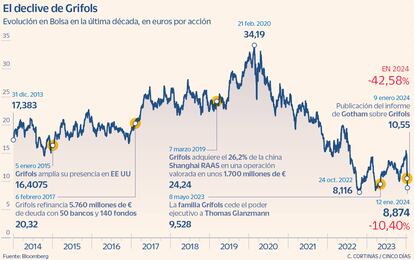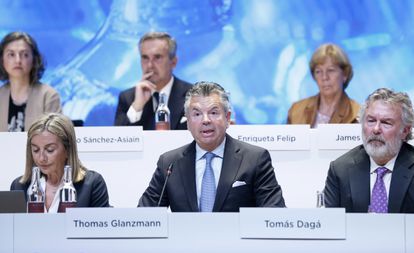An earthquake shook the Spanish financial world on Tuesday. Grifols, the Catalan blood products company and one of the most admired companies on the Ibex 35, became the scapegoat of Gotham City Research. This American firm specializes in betting on the depreciation of listed companies and was already well known in Spain for having brought down little Gowex a decade ago. Your report on Grifols denounces accounting engineering that borders on fraud. The diagnosis is devastating: the company's shares could be worthless.
Gowex was a shot at the pigeon but Grifols is big game. The target of the attack was worth 20 billion euros in 2020 and has the support of banks and well-known managers. Hernán Cortés, a veteran investor and founder of the firm Olea Gestión, recognizes that “an attack of this type has never been seen in Spain, and it is possible that the battle will last months.”
For the small investor, the situation is more than uncomfortable. The darling of Spanish finance – whose shares traded at 34 euros, at their highest four years ago – is now trading at less than nine euros. Although it had been declining for years, on Tuesday they took a hit of 26% and for the whole week they lost almost 40%. And a few days before they continued dazzling the market.

Who is behind the attack
The famous report was issued by the firm Gotham City Research but this is no longer the same as in 2014. Last year, its creator, Daniel Yu, partnered with a hedge fund London bearish to create the GIP fund, which can raise resources from third parties for these operations. In addition, the entity has accumulated experience: Gotham has participated in a dozen bearish bets, with notable success. On this occasion, his GIP fund has been accompanied by the also bearish AKO Capital. Both closed most of their positions in Grifols after dealing the first blow.
What's going to happen now
Gotham and its allies have already pocketed more than 25 million euros with the Grifols stock market crash. But they are not satisfied. GIP sources explain by email to Five days who have been analyzing the company's accounts since spring 2023 and who continue to “see it as incorrect that there are two companies, Grifols and Scranton, that completely consolidate the results of the subsidiaries Haema AG and BPC Plasma.”
The relationship between Scranton and Grifols is at the core of Gotham's sharp criticism. They do not understand the multiple cross-relationships: they share the Grifols family as shareholders and the first has 8.7% of the capital of the second, in addition to being the owner of the group headquarters and the aforementioned plasma production subsidiaries (Haema and BCP) which, however, consolidates Grifols. The suspicion of bearish investors is that “companies linked to the parent company are being used to convey a perception of less debt than is real,” as they explain. If Grifols did not integrate the activity and income of these companies, its debt-to-EBITDA leverage ratio would skyrocket to between 10 and 13 times, Gotham denounces. At the center of the controversy is the fact that Grifols sold the Haema and BCP firms to Scraton in 2018 but continues to integrate them into its accounts with the argument that it retains a purchase option.
/cloudfront-eu-central-1.images.arcpublishing.com/prisa/JUWKLMQANFJ5J3EWNNU7ZWMAZA.jpg)
On Thursday, Grifols management organized a conference with investors to clarify relations with Scranton. The battery of arguments deployed did not convince the market and the shares plummeted another 16%. Investors' fear is that Gotham, GIP and other bears will continue to launch barbs against the pharmaceutical company, raising doubts about its accounts and corporate governance.
Courts and financing
To defend itself from the attacks of short investors, and their denunciation of accounting irregularities, Grifols has announced that it will take legal action against Gotham City Research “for the significant damage caused, both financial and reputational, to the company, as well as to all of its 'stakeholders' [accionistas, empleados, proveedores…] and for causing great concern to his patients and donors.”
The problem is that judicial times and stock market times are different. Some advance in decades and others in microseconds. By the time a court can rule in favor of Grifols, the company may have already been bled dry.
The key is in the story. Will Grifols be able to convince institutional shareholders that its accounting exoticism is acceptable and does not affect its business model? Will he manage to spread the idea that the level of debt is controlled and will decrease?
In parallel, Grifols' administrators will have to manage a very high level of leverage, six times its EBITDA (10 times according to Gotham's thesis). The future of the action and the judicial derivatives may complicate the a
sset sales that the group had planned or the refinancing of credits. In addition, some of the operations were backed by the company's own stock securities. With its depreciation, the entire financial framework becomes complicated. A group of vulture funds is already planning on the company, knowing that Grifols will have to sell assets with much more pressure and urgency than expected.
Meanwhile, the National Securities Market Commission (CNMV) has given a 10-day ultimatum to Grifols to explain its cross operations with Scranton. The supervisor, who has refused to suspend the listing to protect it from attacks, wants to gather information “to see which aspects of the information have to be reviewed or analyzed,” according to the president of the CNMV, Rodrigo Buenaventura. The organization fears that the reported accounting operations have not only falsified the group's real image but have harmed the interests of small shareholders.
/cloudfront-eu-central-1.images.arcpublishing.com/prisa/C2X5YDBXY7WSOPLMW5FUCGQE2Q.jpg)
Vega Alonso (EFE)
Among the supports that Grifols has are a group of prestigious Spanish management companies (Bestinver, AzValor, Cobas AM) that have accepted the explanations about the accounting frameworks of the group and the family. Some of them claim to be considering taking advantage of the falls to expand their participation. Furthermore, large banks such as Bank of America, BNP Paribas, BBVA, CaixaBank and Santander have lent money to both Grifols and Scranton, and have no incentive to contribute to the collapse of the stock. Instead, the American giant Capital Group (the largest shareholder not linked to the family) has reduced its stake.
The role of minorities
The forgotten ones in this battle between the bears, the family and the large funds are the retailers. Those who had Grifols shares for four years have seen them lose 73% of their value. In part, due to the aggressive international expansion campaign that led the group to buy many businesses and take on a lot of debt. And, in part, due to the use of satellite companies for questionable purposes.
“One of the market's fears is that the Grifols family, which has significant weight in Scranton, has used this company to disguise the group's accounts to make them more attractive,” explains a fund manager.
There is already an American law firm, Holzer & Holzer, based in Atlanta, which has announced that it is investigating whether Grifols could have bypassed the legislation with that intention. The firm is considering taking legal action against its administrators, and is looking for small investors who want to be represented in the lawsuit. The Spanish firm Cremades & Calvo Sotelo is also considering taking the company to court under accusation of a possible crime of defrauding investors and accounting falsehood.
In the past, minority shareholders of Pescanova, Abengoa, Bankia or Banco Popular or Gowex, played an important role in the judicial drift of cases.
Lawyers fear that the founding family has been deriving cash flows and debt allocations, at convenience, thinking more about their own interests than those of Grifols' shareholders as a whole.
Debt and governance
In the battle for the story, it will be essential for the management of the blood products company to improve its structure and corporate governance. “We ruled out that company due to governance and having a very aggressive financial strategy. The 9,000 million debt is his, Gotham has not created it,” Beltrán de la Lastra, president of Panza Capital and one of the most recognized Spanish managers, pointed out on Thursday.

Regarding the governance structure of the pharmaceutical company, the Gotham report adds that the new executive president, Thomas Glanzmann (since May 2023), was aware of all the questioned operations, since he has been a director since 2006. Although the real focus on any corporate movement in recent years should position itself on Raimon Grifols (corporate director of the multinational) and Tomás Dagá, the two managers who remain on the board and who have led the group since Víctor Grifols, architect of the company, retired from the front line. the strong expansion.
Other famous cases of bearish attacks in the United States have lasted up to five years, causing a drain on resources for both sides, both in lawyers and in public relations. It remains to be seen if in this battle between Grifols and its attackers there is enough financial ammunition for a long fight.
Follow all the information Five days in Facebook, x and Linkedinor in our newsletter Five Day Agenda
The Five Day Agenda
The most important economic quotes of the day, with the keys and context to understand their scope
_
#Practical #guide #small #Grifols #shareholder